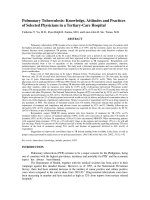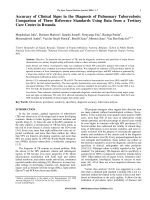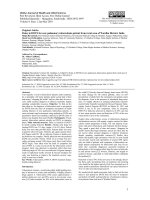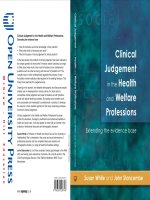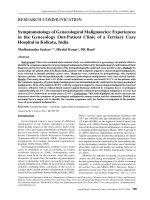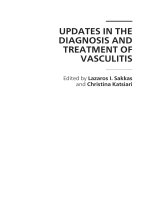Accuracy of Clinical Signs in the Diagnosis of Pulmonary Tuberculosis: Comparison of Three Reference Standards Using Data from a Tertiary Care Centre in Rwanda doc
Bạn đang xem bản rút gọn của tài liệu. Xem và tải ngay bản đầy đủ của tài liệu tại đây (117.41 KB, 7 trang )
The Open Tropical Medicine Journal, 2008, 1, 1-7 1
1874-3153/08 2008 Bentham Science Publishers Ltd.
Accuracy of Clinical Signs in the Diagnosis of Pulmonary Tuberculosis:
Comparison of Three Reference Standards Using Data from a Tertiary
Care Centre in Rwanda
Mugabekazi Julie
1
, Boelaert Marleen
2
, Sarushi Joseph
1
, Seruyange Eric
1
, Basinga Paulin
3
,
Musemakweli André
4
, Van der Stuyft Patrick
2
, Bisoffi Zeno
5
, Moreira Juan
1
, Van Den Ende Jef
1,2,
*
1
Centre Hospitalier de Kigali, Rwanda;
2
Institute of Tropical Medicine, Antwerp, Belgium;
3
School of Public Health,
National University of Rwanda;
4
National University of Rwanda and
5
Centro per le Malattie Tropicali, Negrar, Verona,
Italy
Abstract: Objective: To determine the prevalence of TB, and the diagnostic sensitivity and specificity of major disease
characteristics in a tertiary hospital setting in Rwanda, relative to three reference standards.
Study Design and Setting: A prospective study was conducted in which 300 consecutive patients with cough of at least
2-weeks duration were evaluated at a tertiary healthcare facility. We compared the estimates of TB prevalence and the di-
agnostic accuracy of fever, haemoptysis, sputum smear microscopy, radiological signs, and HIV infection as generated by
a latent class analysis (LCA) with those given by culture and by a composite reference standard (CRS), which relied on
bacteriological confirmation and/or cavities.
Results: LCA estimated the prevalence of TB at 44%. The most sensitive characteristics were fever (90%) and HIV infec-
tion (86%), but both lacked specificity. The most specific characteristics were microscopy (99%), X-Ray cavities (97%)
and apical infiltrates (93%). When culture was taken as a reference standard, the prevalence was 38%; for the CRS, it was
45%. For both, the diagnostic sensitivity and specificity were comparable to those obtained with LCA.
Conclusion: Three reference standards produced comparable diagnostic sensitivities and specificities using major symp-
toms and signs of pulmonary TB; only LCA allowed estimating the diagnostic characteristics of culture. Both LCA and
CRS estimated the probability of disease higher than culture alone.
Key Words: Tuberculosis, prevalence, sensitivity, specificity, diagnostic accuracy, latent class analysis.
INTRODUCTION
In the last century, gradual regression of tuberculosis
(TB) was observed in all developed and in most developing
countries, thanks to better hygiene, improved nutrition and
specific drugs [1, 2]. Since the start of the HIV pandemic in
the early eighties a recrudescence of TB has been noted, as
the risk of overt disease is closely related to the CD4 count
[3-6]. Every year, more than eight million new cases are re-
ported worldwide, and more than three million die. More
than 95% are found in developing countries, and more than
80% are young adults. In 1993 the World Health Organiza-
tion (WHO) declared tuberculosis a worldwide emergency
[1, 2].
The diagnosis of TB remains an eternal problem. With
the advent of the HIV pandemic clinical and radiological
aspects of TB became even more unspecific [7-9]. Direct
microscopical examination with Ziehl stain and culture
lacked sensitivity, and culture results arrived late, sometimes
reported months after ordering [10]. Moreover, in many hos-
pital settings in developing countries new diagnostic tech-
niques such as broncho-alveolar lavage (BAL), rapid culture
(Bactec
) and PCR have been unavailable.
*Address correspondence to this atuhor at the Nationalestraat 155, 2000
Antwerp, Belgium; Tel: +32(0)3/247.64.29; Fax: +32(0)3/247.64.52;
E-mail:
TB program managers often suggest that clinicians treat
too many patients without bacteriological evidence. Never-
theless, if one would only treat sputum smear-positive (SSP)
cases, more than 50% of true cases of tuberculosis would
remain untreated, and this percentage of missed cases would
be even higher in countries with high HIV prevalence [11].
Several studies have addressed the validity of clinical diag-
nosis of tuberculosis in low-income countries, and were re-
cently reviewed with the purpose of assessing the appropri-
ateness and usefulness of the criteria used in the diagnosis
and the decision to treat [8]. Every proposed approach has its
own strengths and limitations. Some authors use culture as
the reference standard to assess the diagnostic sensitivity and
specificity of clinical, radiographic and other predictors
[10,12,13]. Although culture is widely regarded as the “gold
standard” for pulmonary TB diagnosis and its specificity is
assumed to be 100%, its diagnostic sensitivity remains below
100%. Other authors rely on expert review, exhaustive clini-
cal investigation, histological features or success of treat-
ment [14]. All of these are at best imperfect reference stan-
dards [15].
“Latent class analysis” (LCA) was suggested as a solu-
tion when a validated gold standard is lacking [16]. LCA is a
statistical method developed in the social sciences and intro-
duced in biomedicine in the early eighties. It allows for the
estimation of prevalence (prior probability of disease) and
2 The Open Tropical Medicine Journal, 2008, Volume 1 Julie et al.
sensitivity and specificity of disease characteristics in the
absence of a reliable reference standard [17-19]. LCA has
been used in diagnostic accuracy studies in various infec-
tious diseases, e.g., in Chagas disease, leishmaniasis, schis-
tosomiasis, leptospirosis, Herpesvirus 8 and pneumococcal
infection [20-26].
This study intends to estimate the prior probability of TB,
and the diagnostic sensitivity and specificity of major disease
characteristics for TB in a group of patients admitted to a
tertiary hospital setting in Rwanda. It compares 3 reference
standards: 1) culture; 2) a composite reference standard (di-
rect microscopy and/or culture and/or cavities on chest X-
ray); and 3) a classification obtained with LCA.
MATERIAL AND METHODS
This prospective study was conducted over a three
months period in the public wards of internal medicine of
CHK, a 600-bed hospital of national referral center in
Rwanda. Three hundred consecutive patients who were hos-
pitalized with a cough of at least 2 weeks duration were in-
cluded in the study. Extra-pulmonary TB (including miliary
TB) and patients already under TB treatment were excluded.
The following data were collected: age and sex; history
of fever; night sweats; haemoptysis; direct microscopy of
sputum with Ziehl stain; culture of sputum on Löwenstein
Jensen medium; HIV enzyme linked serum assay (ELISA)
(VIRONOSTICA
bioMérieux, Marcy-l'Etoile) with confir-
mation by a second ELISA if positive (MUREX DIAG-
NOSTICS
, Abbott, Dartford); a Western Blot test (HIV
BLOT 2.2
Genelabs Diagnostics, Singapore) in case of a
discordant result; chest x-ray read by a radiologist and an
internist or by three internists on a consensus base, all
blinded to previously obtained clinical information. Direct
microscopy was considered positive if two out of three
specimens contained at least one + mark of acid-fast bacilli;
if only one sputum was positive, or if two were questionable,
another series of three sputa was performed.
All clinical and laboratory testing was part of routine
examination. For HIV testing, specific informed consent was
asked and counseling offered. Approval for this study was
obtained from the relevant authorities of the Ministry of
Health of Rwanda.
The diagnostic sensitivity (Se) and specificity (Spe) of
clinical signs and symptoms were assessed as follows: first, a
classical bivariate analysis was performed with culture as the
reference standard. Second, we compared disease character-
istics with a composite reference standard, which considered
a patient with a positive culture, and/or at least two positive
smears, and/or thick walled cavities on chest X-ray as “a
case of TB”. Only patients who were negative on all three
criteria were considered as “no-TB”. Third, we estimated Se
and Spe of disease characteristics with an LCA strategy
[17,27,28]
In patients for whom results from at least 3 diagnostic TB
tests are available, LCA can distinguish two subgroups: “pa-
tients with pulmonary TB” and “patients without pulmonary-
TB”. The true disease status of these persons is considered as
a “latent variable” with two mutually exclusive and exhaus-
tive categories, “TB” and “no-TB”. Observed diagnostic test
results in this study including clinical, bacteriological and
radiological findings do not permit the measurement of dis-
ease status directly, because they are all (imperfect) indica-
tors of the underlying latent variable “disease status”.
In a cohort, different patterns of findings can be present:
if we limit the example to tuberculosis and to three findings,
some patients will present fever, cavities, and a positive
smear, others cavities and a positive smear but no fever, oth-
ers fever and a positive smear but no cavities, and so on. The
observed numbers of patients in each pattern form a series, a
“constellation”, which can not be solved directly mathemati-
cally, but iterative application of algorithms can deduce the
probability of each test pattern for the hypothetical disease,
the prevalence of the hypothetical disease, and the diagnostic
sensitivity and specificity. Different models can be tested for
“fit”: the calculated frequency of each pattern, based on the
data estimated by the model, is compared with the frequency
observed in reality. A low p-value means bad modeling,
since there is a significant difference between the observed
frequency (in the cohort) and the computed frequency (based
on the proposed prevalence, Se and Spe).
In basic latent class models, the observed or manifest
variables are assumed to be independent conditional on la-
tent class. In advanced models this condition is relaxed
[27,29]. Conditional independence of the manifest variables
is usually examined by inspecting the residual correlation
between pairs of tests after fitting the basic LCA model. If
significant, a more complex LCA model should be fitted to
the data that includes a term describing this direct depend-
ence between the two tests. Basic and complex models are
then compared and if the complex model accounting for
conditional dependence does not provide a significantly bet-
ter fit to the data, the basic LCA model will be preferred [26]
We fitted several series of latent class models to our data
with the LATENT GOLD package (V 2.0.18, Statistical In-
novations, Belmont, MA). We included in the analysis only
variables that showed Se + Spe > 1 in the comparison with
culture (direct microscopy, cavities, apical infiltrates, HIV
infection, haemoptysis and fever). We identified the LCA
model providing the best fit to the data by comparing the
difference in likelihood statistic (L), the Bayesian Informa-
tion Criterion (BIC) and Akaike’s Information Criterion
(AIC) [30]. The best LCA model provided the parameters of
interest, and an approximate 95% CI was computed for Se
and Spe as the interval lying within ±1.96*standard error of
the estimate.
RESULTS
Of 300 patients 175 were female, 125 male. Median age
was 36 years (15 to 87). Direct sputum microscopy was posi-
tive in 88, culture in 115 and HIV Elisa in 216 patients. Of
88 patients with positive direct microscopy, 13 were culture
negative. Of 115 patients with a positive culture, 40 had a
negative direct sputum examination. Cavities were present in
34 and apical infiltrations in 73 patients. There were no
missing data on any of the tests or signs for the 300 patients.
Classical contingency table analysis showed a significant
correlation of direct microscopy, cavities, apical infiltrates
and HIV infection with culture. Reticulo-nodular infiltrates
were inversely correlated with positive culture, but this find-
ing was excluded for further analysis because of possible
bias through miliary TB (Table 1).
Three Reference Standards For Pulmonary TB The Open Tropical Medicine Journal, 2008, Volume 1 3
Table 2 displays an overview of well-fitting LCA mod-
els. Model 1 is a basic two-Latent Class model with seven
disease characteristics. Model 2 includes the 7 characteris-
tics of model 1 and includes moreover direct dependence
between cavities and unilateral apical infiltrates, haemoptysis
and cavities, and unilateral apical infiltrates and fever. This
model provided significant better fit to the data than model
1. Model 3 is a three-latent class model that fitted the data
well, but the interpretation was not meaningful. It separated
patients with cavities from patients with upper lobe consoli-
dation, a clinically less relevant distinction. Model 4 was
constructed in an attempt to remove the less discriminant
signs haemoptysis (low sensitivity) and fever (low specific-
ity) from the model. While it resulted in very similar pa-
rameter estimates of Se and Spe, model fit was poor. Model
5, controlling for dependence between cavities and unilateral
apical infiltrates, did not improve the fit of the model 4.
LCA-Model 2 was identified as the best model. It
showed a TB prevalence of 44% and good diagnostic sensi-
tivity for fever, HIV infection, direct microscopy and cul-
ture. On the other hand haemoptysis, cavities, apical infil-
trates, direct microscopy and culture showed good specific-
ity.
Table 3 compares estimates for Se, Spe and prevalence
obtained by bivariate analysis with culture and composite
reference standard and by the LCA approach. Most values
are similar, only the prevalence of TB and the specificity
estimate for direct microscopy were substantially different
(although non-significant for the former).
Table 4 shows the different observed combinations of
disease characteristics as well as the expected frequencies
predicted by Model-2. Of 128 (2
7
) possible patterns, 55 were
observed. For each pattern, the post-test probability was
Table 1. Prevalence of TB, Sensitivity (%), Specificity (%) and Odds Ratio (95% C.I.) of Disease Characteristics Compared to
Culture as Reference Standard (n=300)
Culture Positives
n=115
Sensitivity
Culture Negatives
n=185
Specificity Odds Ratio
Fever or nightsweats 102 89 161 13 1.17 (CI : 0.54-2.57)
Haemoptysis 23 20 29 84 1.34 (CI : 0.70-2.58)
Apical infiltrates 45 39 28 85 3.60 (CI : 2.00-6.52)
Cavities 25 22 9 95 5.43 (CI : 2.28-13.25)
Bilateral infiltrates 28 24 56 70 0.74 (CI : 0.42-1.31)
Basal infiltrates 34 30 67 64 0.74 (CI : 0.43-1.26)
Reticulonodular Infiltrates 7 06 35 81 0.28 (CI : 0.11-0.69)
HIV infection 100 87 116 37 3.97 (CI : 2.04-7.79)
Ziehl stain 75 65 13 93 24.81 (CI : 11.90-52.60)
Table 2. Features of Different LCA Models Fitted to the Data. Numbers of Classes, Manifest Variables and Dependencies, and
Goodness of Fit for the 5 Models
Model
Number of Latent
Classes
Number of Manifest
Variables
Number of Dependencies between
Pairs of Tests Controlled for
L df p-value BIC AIC
1 2 7 0 83.06 112 0.98 -555 -140
2 2 7 3 71.80 109 0.99 -549 -146
3 3 7 0 77.48 104 0.98 -515 -130
4 2 5 0 27.84 20 0.11 -86 -12
5 2 5 1 23.51 19 0.21 -84 -14
Models 1-3 are based on direct microscopy, cavities, apical infiltrates, haemoptysis, fever, HIV infection and culture. In model 4 and 5 we remove findings with lower discriminative
power: haemoptysis (low sensitivity) and fever (low specificity). In model 2 and 5 we control for conditional independence of the manifest variables.
L
2
: the likelihood ratio chi-squared statistic is used to assess how well the model fits the data. It indicates the amount of the relationship between the variables that remains unex-
plained by a model; the larger the value, the poorer the model fits the data. As a rule of thumb, a good fit is provided by a model when the L
2
for that model is not substantially larger
than the degrees of freedom (df). However, for model comparison, a formal test of the difference in L between the models should be performed, or criteria as BIC or AIC should be
used.
BIC: Bayesian Information Criterion for model comparison. Lowest BIC corresponds to best model fit.
AIC: Akaike’s Information Criterion.
4 The Open Tropical Medicine Journal, 2008, Volume 1 Julie et al.
computed based on estimated parameters. All patients with
patterns yielding over 80% of post-test probability were bac-
teriologically confirmed. Fourteen HIV positive patients had
only fever and a positive culture. Six patients with cavities
were classified as low probability (<50%).
DISCUSSION
Our study yielded consistent estimates for the diagnostic
accuracy of clinical and radiological signs and symptoms
with three different reference standards. Both a latent class
and a composite reference standard approach suggested that
the prevalence of TB in this group of patients was approxi-
mately 44%, and thus a relative 16% higher than if estimated
by culture alone (38%). The high prevalence of TB can be
explained by the tertiary care level and by the frequent co-
infection HIV-TB. Together with the high HIV prevalence,
the tertiary care level probably explains also the frequency of
microscopy negative cases (false negative rate 34% with the
best LCA model), since most sputum smear-positive patients
are treated at the level of the health centre or the district hos-
pital.
The higher TB prevalence estimated by the latent class as
well as composite reference standard approach compared to
the culture as reference standard is not surprising, since
“closed focus” pulmonary TB exists, and since the diagnos-
tic sensitivity of culture is below 100% [10,12,31]. During
the preparation of the sample, decontamination diminishes
the bacterial load considerably; bacterial overgrowth, defec-
tive culture media, excessive delay between sputum collec-
tion and inoculation and a too short reading period are other
causes of false negative cultures [32,33]. Therefore, and not
surprisingly, the specificity of direct microscopy was esti-
mated as higher with the LCA than in the classical approach
compared to culture.
We acknowledge that the patient group studied is subject
to selection bias and we do not want to claim that the esti-
mates for Se, Spe and prevalence obtained in this study are
valid beyond a tertiary-care level in a region with a high HIV
prevalence. Patients admitted to the study ward in Kigali
were already filtered by the health system, and are not repre-
sentative for those admitted to a district hospital in Rwanda
e.g. Especially the specificity estimates will be affected by
this bias, but the considerable presence of sputum smear-
negative cases in our study group may also affect the sensi-
tivity estimates of certain disease characteristics. By exclud-
ing all patients already under treatment, we excluded the
majority of multidrug resistant TB, though these are still
rather rare in Rwanda (3.9% of new cases) [34]. The exclu-
sion of miliary TB and TB pleurisy was dictated by the fact
that we focused on pulmonary TB sensu stricto.
As for the choice of variables, we did not include the
response to a treatment with an antibiotic, since most pa-
tients already received several courses of antibiotics at the
referring level. Moreover, the value of this “clinical test” has
been challenged [35].
LCA led in this study to broadly similar sensitivity and
specificity estimates of disease characteristics as two alterna-
tive reference standards: a composite reference standard, as
well as an external reference standard (culture). Notwith-
standing the above design limitations (e.g., selection of pa-
tients at reference level), our findings are not dissimilar from
those of other authors. A good sensitivity of fever and HIV
infection, and a high specificity of haemoptysis and cavities
have been found also in a study done in Burundi and Tanza-
nia in 1997, also at a reference level, with culture as gold
standard [14]. Direct microscopy had a moderate, and culture
a good sensitivity, also in the study by Von Gottberg et al.
[36]. The non-negligible sensitivity of direct microscopy at
our reference level was somehow unexpected. It suggests
that human error could have been a contributing factor or
that patients became smear positive between first attendance
and referral.
Table 3. Parameter Estimate Provided by Different Methods. Prevalence, Sensitivities and Specificities for the Preferred Model of
LCA, the Model with Culture Alone and the Model with the Composite Reference Standard
Best LCA model (model 2)
Classical analysis with culture
as reference standard
Classical analysis with composite
reference standard
Se Spe Se Spe Se Spe
Fever or nightsweats 91 (85-96) 14 (9-20) 89 (81-94) 13 (8-19) 89 (82-94) 13 (9-20)
Haemoptysis 20 (13-28) 86 (80-91) 20 (13-28) 84 (78-89) 22 (15-30) 86 (80-91)
Ziehl stain 66 (56-76) 99 (98-100) 65 (56-74) 93 (88-96) 64 (56-73) n.a.
Cavities 21 (14-29) 97 (94-100) 22 (15-30) 95 (91-98) 25 (18-33) n.a.
Apical infiltrates 42 (33-52) 90 (85-95) 39 (30-49) 85 (79-90) 39 (31-48) 87 (82-92)
HIV infection 88 (82-94) 40 (33-48) 87 (80-93) 37 (30-45) 85 (78-91) 39 (32-47)
Culture 84 (77-92) 98 (93-100) n.a n.a. 84 (77-90) n.a.
Prevalence 44 (37-51) 38 (33-44) 45 (40-51)
n.a.: not applicable; confidence intervals between brackets.
Values that are different between models are underlined.
Three Reference Standards For Pulmonary TB The Open Tropical Medicine Journal, 2008, Volume 1 5
Table 4. Model 4, the Posterior Probability for the TB Class, the Expected, Actual and Cumulative Number of Patients Per Com-
bination of Disease Characteristics
Fever or
Nightsweats
Haemo-
ptysis
Cavities
Apical
Infiltrates
HIV
Infection
Culture Ziehl Stain
Estimated
Frequency
Observed
Frequency
Cumulative
Numbers
Posterior
Probability of TB
Y Y Y Y Y Y Y 0.9 2 2 1.00
Y Y N Y Y Y Y 3.7 3 5 1.00
N Y N Y Y Y Y 0.7 1 6 1.00
Y N Y N Y Y Y 6.3 8 14 1.00
N N N Y Y Y Y 2.9 3 17 1.00
Y N Y Y Y Y Y 1.8 2 19 1.00
N N Y N Y Y Y 0.5 1 20 1.00
Y Y Y N Y Y Y 3.2 4 24 1.00
Y N N Y Y Y Y 15.7 14 38 1.00
Y N N Y N Y Y 2.2 5 43 1.00
Y Y Y N N Y Y 0.5 1 44 1.00
Y Y N N Y Y Y 4.9 4 48 1.00
N N N Y N Y Y 0.4 2 50 1.00
Y N N N Y Y Y 21.0 20 70 1.00
N N N N Y Y Y 1.8 2 72 1.00
Y Y N N N Y Y 0.7 1 73 1.00
Y N N N N Y Y 2.9 1 74 1.00
N N N N N Y Y 0.2 1 75 1.00
Y Y N Y Y N Y 0.7 2 77 0.99
Y N Y N Y N Y 1.2 1 78 0.99
Y Y Y N Y Y N 1.7 2 80 0.99
Y N N Y Y N Y 2.9 1 81 0.99
N Y N Y Y N Y 0.1 1 82 0.99
Y Y N Y Y Y N 1.9 2 84 0.99
Y N Y N Y Y N 3.3 4 88 0.99
Y N N Y Y Y N 8.2 9 97 0.98
N N N Y Y Y N 1.6 1 98 0.98
Y Y N N Y N Y 0.9 2 100 0.97
Y N N Y N N Y 0.4 1 101 0.96
Y N N N Y N Y 4.1 5 106 0.95
Y Y N N Y Y N 2.7 3 109 0.94
Y N N Y N Y N 1.2 1 110 0.93
N N Y N N Y N 0.0 1 111 0.92
Y N N N Y Y N 12.0 14 125 0.91
N N N N Y Y N 1.1 1 126 0.86
Y Y Y Y Y N N 0.1 1 127 0.73
Y N N N N Y N 2.3 2 129 0.67
Y N Y Y Y N N 0.3 1 130 0.64
Y N Y Y N N N 0.1 1 131 0.27
Y Y N Y Y N N 1.5 1 132 0.24
Y N Y N Y N N 2.8 1 133 0.22
Y N N Y Y N N 8.8 9 142 0.17
N N Y N Y N N 0.4 1 143 0.14
N N N Y Y N N 2.5 5 148 0.11
Y Y Y N N N N 0.5 1 149 0.08
Y Y N Y N N N 0.8 1 150 0.06
Y N Y N N N N 1.6 2 152 0.05
Y Y N N Y N N 10.0 10 162 0.05
Y N N Y N N N 5.2 4 166 0.04
Y N N N Y N N 65.4 66 232 0.03
N Y N N Y N N 1.3 2 234 0.03
N N N N Y N N 8.9 7 241 0.02
Y Y N N N N N 6.6 8 249 0.01
Y N N N N N N 43.4 43 292 0.01
N N N N N N N 5.9 8 300 0.00
Posterior probability of TB: the calculated posterior probability for patients with each pattern of belonging to the TB class, based on estimated prevalence, se and spe. The columns
“expected frequency” and “observed frequency” allow comparison between the calculated frequency within each pattern, based on the data estimated by the model, with the expected,
or observed in reality.
The last two columns show the post-test probability of a pattern, and the cumulative number of patients exceeding this post-test probability. All patients having over 80% of post-test
probability had bacteriological confirmation. Fourteen HIV positive patients had only fever and a positive culture. Six patients with cavities were classified as low probability (<50%).
6 The Open Tropical Medicine Journal, 2008, Volume 1 Julie et al.
LCA has been used widely in veterinary medicine, but in
human infectious disease the literature is still scarce. Five
studies compared LCA results with another reference stan-
dard, and 3 estimated higher prevalences of disease with
LCA [21,22,25]. Pirard et al. evaluated screening tests for
Chagas disease and report a lower prevalence of infection
with LCA, compared to the composite reference standard
(i.e. positivity in all tests) [26]. Butler evaluated tests for
pneumococcal disease and found no difference between the
estimates by LCA and those based on a reference standard
[23]. Whether LCA will yield or not similar estimates com-
pared to classical methods is highly dependent on the nature
and degree of misclassification by the reference standard it is
compared with.
LCA might be a useful tool that provides insight in the
problem of misclassification by imperfect reference stan-
dards, when validating diagnostic signs and symptoms. The
composite reference standard evaluated in our study reached
similar disease prevalence and sensitivity and specificity
estimates as LCA, and was promoted by Alonzo and Pepe as
more transparent and more reliable than LCA [37]. However,
one might question the classification by the CRS of six pa-
tients with negative bacteriology and positive radiological
findings as “certain” TB. LCA generated low post-test prob-
abilities for these six patients; although clinicians would treat
several of them, we can not consider them as “reference” TB
cases.
The advantage of LCA compared to the composite refer-
ence standard is that, in our study, LCA allowed for the es-
timation of the specificity of “culture”, “smear microscopy”,
and “cavities on X-ray” in a non-deterministic way, whereas
the CRS considered them as 100 % specific by definition.
Most interestingly, LCA and not CRS, allowed us to exam-
ine the performance of culture as a reference test for TB di-
agnosis in this data set. More generally, LCA produces esti-
mates that take into account the existing uncertainty sur-
rounding the performance of the so-called reference stan-
dard.
Clinical decisions regarding TB status should be made
taking into account the final post-test probability after ex-
ploring all findings, and comparing this probability with the
therapeutical threshold. LCA as such has no direct role in
patient-by-patient clinical case management of TB, but it
expands our toolbox in clinical research, as it is one of the
few statistical techniques available to address the issue of
prevalence, sensitivity and specificity estimation when no
gold standard exists to do so. As far as it allows us to flag
(and correct for some of) the misclassification bias that crip-
ples many of our diagnostic accuracy studies, we feel LCA is
a useful methodological addition.
CONCLUSION
This study shows that the latent class approach in diag-
nostic accuracy study gave consistent estimates of sensitivi-
ties and specificities of symptoms and signs, when compared
to the classical culture or a composite reference standard.
However, both LCA and the composite reference standard
suggest a higher disease prevalence than culture alone. The
superiority of LCA relies in its ability to examine the per-
formance of culture, the classical reference test.
REFERENCES
[1] WHO Report 2002: Global Tuberculosis Control. Surveillance,
planning, finance. Geneva: World Health Organisation, 2002.
[2] Frieden TR, Sterling TR, Munsiff SS, et al. Tuberculosis. Lancet
2003; 362: 887-899.
[3] Glynn JR. Resurgence of tuberculosis and the impact of HIV infec-
tion. Br Med Bull 1998; 5: 579-593.
[4] Cantwell MF, Binkin NJ. Impact of HIV on tuberculosis in sub-
Saharan Africa: a regional perspective. Int J Tuberc Lung Dis
1997; 1: 205-214.
[5] Batungwanayo J, Taelman H. Impact of immunodeficiency virus
infection on tuberculosis in Kigali, Rwanda: One year study of
377consecutive cases. Int J Infect Dis 1996; 22-27.
[6] Lawn SD, Butera ST, Shinnick TM. Tuberculosis unleashed: the
impact of human immunodeficiency virus infection on the host
granulomatous response to Mycobacterium tuberculosis. Microbes
Infect 2002; 4: 635-646.
[7] Batungwanayo J, Taelman H, Dhote R, et al. Pulmonary tuberculo-
sis in Kigali, Rwanda. Impact of human immunodeficiency virus
infection on clinical and radiographic presentation. Am Rev Respir
Dis 1992; 146: 53-56.
[8] Siddiqi K, Lambert ML, Walley J. Clinical diagnosis of smear-
negative pulmonary tuberculosis in low-income countries: the cur-
rent evidence. Lancet Infect Dis 2003; 3: 288-296.
[9] Lee MP, Chan JW, Ng KK, Li PC. Clinical manifestations of tu-
berculosis in HIV-infected patients. Respirology 2000; 5: 423-426.
[10] Apers L, Mutsvangwa J, Magwenzi J, et al. A comparison of direct
microscopy, the concentration method and the Mycobacteria
Growth Indicator Tube for the examination of sputum for acid-fast
bacilli. Int J Tuberc Lung Dis 2003; 7: 376-381.
[11] Colebunders R, Bastian I. A review of the diagnosis and treatment
of smear-negative pulmonary tuberculosis. Int J Tuberc Lung Dis
2000; 4: 97-107.
[12] Crampin AC, Floyd S, Mwaungulu F, et al. Comparison of two
versus three smears in identifying culture-positive tuberculosis pa-
tients in a rural African setting with high HIV prevalence. Int J Tu-
berc Lung Dis 2001; 5: 994-999.
[13] Kanaya AM, Glidden DV, Chambers HF. Identifying pulmonary
tuberculosis in patients with negative sputum smear results. Chest
2001; 120: 349-355.
[14] Samb B, Henzel D, Daley CL, et al. Methods for diagnosing tuber-
culosis among in-patients in eastern Africa whose sputum smears
are negative. Int J Tuberc Lung Dis 1997; 1: 25-30.
[15] Barnes PF, Cave MD. Molecular epidemiology of tuberculosis. N
Engl J Med 2003; 349: 1149-1156.
[16] Hadgu A. The discrepancy in discrepant analysis. Lancet 1996;
348: 592-593.
[17] Goodman L. The analysis of systems of qualitative variables when
some of the variables are unobservable. Part I - a modified latent
structure approach. Am J Soc 1974; 79: 1179-1259.
[18] Rindskopf D, Rindskopf W. The value of latent class analysis in
medical diagnosis. Stat Med 1986; 5: 21-27.
[19] Formann AK, Kohlmann T. Latent class analysis in medical re-
search. Stat Methods Med Res 1996; 5: 179-211.
[20] Bajani MD, Ashford DA, Bragg SL, et al. Evaluation of four com-
mercially available rapid serologic tests for diagnosis of leptospiro-
sis. J Clin Microbiol 2003; 41: 803-809.
[21] Boelaert M, Rijal S, Regmi S, et al. A comparative study of the
effectiveness of diagnostic tests for visceral leishmaniasis. Am J
Trop Med Hyg 2004; 70: 72-77.
[22] Booth M, Vounatsou P, N goran EK, et al. The influence of sam-
pling effort and the performance of the Kato-Katz technique in di-
agnosing Schistosoma mansoni and hookworm co-infections in ru-
ral Cote d'Ivoire. Parasitology 2003; 127: 525-531.
[23] Butler JC, Bosshardt SC, Phelan M, et al. Classical and latent class
analysis evaluation of sputum polymerase chain reaction and urine
antigen testing for diagnosis of pneumococcal pneumonia in adults.
J Infect Dis 2003; 187: 1416-1423.
[24] Langhi DM, Bordin JO, Castelo A, et al. The application of latent
class analysis for diagnostic test validation of chronic Trypanosoma
cruzi infection in blood donors. Braz J Infect Dis 2002; 6: 181-187.
[25] Pellett PE, Wright DJ, Engels EA, et al. Multicenter comparison of
serologic assays and estimation of human herpesvirus 8 seropreva-
lence among US blood donors. Transfusion 2003; 43: 1260-1268.
Three Reference Standards For Pulmonary TB The Open Tropical Medicine Journal, 2008, Volume 1 7
[26] Pirard M, Iihoshi N, Boelaert M, et al. The validity of serologic
tests for Trypanosoma cruzi and the effectiveness of transfusional
screening strategies in a hyperendemic region. Transfusion 2005;
45: 554-561.
[27] Hadgu A, Qu Y. A biomedical appication of latent class models
with random effects. Appl Stat 1998; 47: 603-616.
[28] Heinen T. Latent Class and Discrete Latent Trait Models. Thou-
sand Oaks: Sage Publications, 1996.
[29] Hagenaars JA. Latent Structure Models with Direct Effects Be-
tween Indicators. Local Dependence Models. Sociological Methods
& Research 1988; 16: 379-405.
[30] Agresti A. Categorical Data Analysis. Second ed. New York: John
Wiley & Sons, 1990.
[31] Ginesu F, Pirina P, Sechi LA, et al. Microbiological diagnosis of
tuberculosis: a comparison of old and new methods. J Chemother
1998; 10: 295-300.
[32] Thornton CG, MacLellan KM, Brink TL, et al. Novel method for
processing respiratory specimens for detection of mycobacteria by
using C18-carboxypropylbetaine: blinded study. J Clin Microbiol
1998; 36: 1996-2003.
[33] Lipsky BA, Gates J, Tenover FC, Plorde JJ. Factors affecting the
clinical value of microscopy for acid-fast bacilli. Rev Infect Dis
1984; 6: 214-222.
[34] Umubyeyi AN, Vandebriel G, Gasana M, et al. Results of a na-
tional survey on drug resistance among pulmonary tuberculosis pa-
tients in Rwanda. Int J Tuberc Lung Dis 2007; 11: 189-194.
[35] Siddiqi K, Walley J, Khan MA, Shah K, Safdar N. Clinical guide-
lines to diagnose smear-negative pulmonary tuberculosis in Paki-
stan, a country with low-HIV prevalence. Trop Med Int Health
2006; 11: 323-331.
[36] von Gottberg A, Sacks L, Machala S, Blumberg L. Utility of blood
cultures and incidence of mycobacteremia in patients with sus-
pected tuberculosis in a South African infectious disease referral
hospital. Int J Tuberc Lung Dis 2001; 5: 80-86.
[37] Alonzo TA, Pepe MS. Using a combination of reference tests to
assess the accuracy of a new diagnostic test. Stat Med 1999; 18:
2987-3003.
Received: October 4, 2007 Revised: November 27, 2007 Accepted: November 27, 2007

